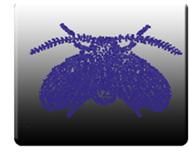Identification of Moth Flies
Update£º2016/3/1 16:08:06 View£º

The key identifying character for the moth fly is the unique pattern of veins in its wings. The entire body and wings of the moth fly are covered with tiny hairs, giving it a moth-like appearance. To the naked eye, this tiny pest might appear to be a small fly with fat wings; the aid of a magnifying glass reveals the unmistakable moth-like appearance. This small fly is no more than 1/8 inch in length including the wings. They are usually black in color.
Moth Fly Biology and Life History
Moth fly adults can be quite annoying in homes, appearing from sinks and bathtub drains. These pests breed in tremendous numbers in sewer plants and are easily blown towards homes by the wind. Their small size enables them to penetrate ordinary fly screens. There have been noted cases of bronchial asthma caused by inhaling the dust resulting from the disintegration of such small flies.
Moth flies lay eggs in a mass of 30 to 100. These eggs hatch in less than 48 hours. The larvae and pupae of the moth fly live in the thin film found in drains, septic tank field lines or filter stones. The larvae feed on sediment, decaying vegetation and microscopic plants and animals. The larval stage lasts from 9 to 15 days and the pupal stage lasts from 20 to 40 hours. The newly emerged adult fly is sexually mature on emergence and copulates within the first few hours of its life.

